Tissue Regression-Related Alterations in the Expression of Adherens and Tight Junction Proteins in the Hen Oviduct
Abstract
1. Introduction
2. Results
2.1. Messenger RNA Transcript Abundance of Tight Junction Protein Genes (OCLN, CLDN1, CLDN4, CLDN5, JAM2, and JAM3) in the Oviduct of Control and Fasted Hens
2.2. Messenger RNA Transcript Abundance of Adherens Junction Protein Genes (CDH1, CTNNB1) in the Oviduct of Control and Fasted Hens
2.3. Abundance of Occludin, E-Cadherin, and β-Catenin Proteins in the Oviduct of Control and Fasted Hens
2.4. Immunofluorescent Localization of Occludin Protein in the Oviduct of Control and Fasted Hens
2.5. Immunofluorescent Localization of E-Cadherin Protein in the Oviduct of the Control and Fasted Hens
2.6. Immunofluorescent Localization of β-Catenin Distribution in the Oviduct of Control and Fasted Hens
3. Discussion
4. Materials and Methods
4.1. Animals and Tissue Collection
4.2. Total RNA Isolation, Reverse Transcription, and Quantitative Real-Time PCR
4.3. Protein Isolation and Western Blot Analysis
4.4. Immunofluorescence
4.5. Statistical Analysis
5. Conclusions
Author Contributions
Funding
Institutional Review Board Statement
Informed Consent Statement
Data Availability Statement
Acknowledgments
Conflicts of Interest
References
- Anderson, J.M.; Van Itallie, C.M. Tight junctions and the molecular basis for regulation of paracellular permeability. Am. J. Physiol.-Gastrointest. Liver Physiol. 1995, 269, G467–G475. [Google Scholar] [CrossRef]
- Mitic, L.L.; Van Itallie, C.M.; Anderson, J.M. Molecular physiology and pathophysiology of tight junctions I. Tight junction structure and function: Lessons from mutant animals and proteins. Am. J. Physiol.-Gastrointest. Liver Physiol. 2000, 279, G250–G254. [Google Scholar] [CrossRef]
- Chen, X.; Lu, Y.; Zhang, Z.; Wang, J.; Yang, H.; Liu, G. Intercellular interplay between Sirt1 signalling and cell metabolism in immune cell biology. Immunology 2015, 145, 455–467. [Google Scholar] [CrossRef]
- Awad, W.A.; Hess, C.; Hess, M. Enteric pathogens and their toxin-induced disruption of the intestinal barrier through alteration of tight junctions in chickens. Toxins 2017, 9, 60. [Google Scholar] [CrossRef]
- Green, K.J.; Jaiganesh, A.; Broussard, J.A. Desmosomes: Essential contributors to an integrated intercellular junction network. F1000Research 2019, 8, 2150. [Google Scholar] [CrossRef] [PubMed]
- Buckley, A.; Turner, J. Cell biology of tight junction barrier regulation and mucosal disease. Cold Spring Harb. Perspect. Biol. 2018, 10, a029314. [Google Scholar] [CrossRef]
- Nys, Y.; Gautron, J.; Rodriguez-Navarro, A.B.; Hincke, M. Mechanisms and hormonal regulation of shell formation: Supply of ionic and organic precursors, shell mineralization. In Sturkie’s Avian Physiology, 7th ed.; Scanes, C.G., Dridi, S., Eds.; Academic Press: Cambridge, MA, USA, 2022; pp. 833–879. [Google Scholar] [CrossRef]
- Hrabia, A. Reproduction in the Female. In Sturkie’s Avian Physiology, 7th ed.; Scanes, C.G., Dirdi, S., Eds.; Academic Press: Cambridge, MA, USA, 2022; pp. 941–986. [Google Scholar] [CrossRef]
- Förster, C. Tight junctions and the modulation of barrier function in disease. Histochem. Cell Biol. 2008, 130, 55–70. [Google Scholar] [CrossRef] [PubMed]
- González-Mariscal, L.; Betanzos, A.; Nava, P.; Jaramillo, B.E. Tight junction proteins. Prog. Biophys. Mol. Biol. 2003, 81, 1–44. [Google Scholar] [CrossRef]
- Will, C.; Fromm, M.; Müller, D. Claudin tight junction proteins: Novel aspects in paracellular transport. Perit. Dial. Int. 2008, 28, 577–584. [Google Scholar] [CrossRef] [PubMed]
- Fanning, A.S.; Jameson, B.J.; Jesaitis, L.A.; Anderson, J.M. The tight junction protein ZO-1 establishes a link between the transmembrane protein occludin and the actin cytoskeleton. J. Biol. Chem. 1998, 273, 29745–29753. [Google Scholar] [CrossRef]
- Nusrat, A.; Brown, G.T.; Tom, J.; Drake, A.; Bui, T.T.; Quan, C.; Mrsny, R.J. Multiple protein interactions involving proposed extracellular loop domains of the tight junction protein occludin. Mol. Biol. Cell 2005, 16, 1725–1734. [Google Scholar] [CrossRef]
- Mendoza-Rodríguez, C.A.; González-Mariscal, L.; Cerbón, M. Changes in the distribution of ZO-1, occludin, and claudins in the rat uterine epithelium during the estrous cycle. Cell Tissue Res. 2005, 319, 315–330. [Google Scholar] [CrossRef]
- Mokhtar, M.H.; Giribabu, N.; Salleh, N. Testosterone reduces tight junction complexity and down-regulates expression of Claudin-4 and Occludin in the endometrium in ovariectomized, sex-steroid replacement rats. Vivo 2020, 34, 225–231. [Google Scholar] [CrossRef]
- Krause, G.; Winkler, L.; Mueller, S.L.; Haseloff, R.F.; Piontek, J.; Blasig, I.E. Structure and function of claudins. Biochim. Biophys. Acta (BBA)–Biomembr. 2008, 1778, 631–645. [Google Scholar] [CrossRef] [PubMed]
- Ebnet, K.; Aurrand-Lions, M.; Kuhn, A.; Kiefer, F.; Butz, S.; Zander, K.; Meyer zu Brickwedde, M.K.; Suzuki, A.; Imhof, B.A.; Vestweber, D. The junctional adhesion molecule (JAM) family members JAM-2 and JAM-3 associate with the cell polarity protein PAR-3: A possible role for JAMs in endothelial cell polarity. J. Cell Sci. 2003, 116 Pt 19, 3879–3891. [Google Scholar] [CrossRef]
- Thomas, F.C.; Sheth, B.; Eckert, J.J.; Bazzoni, G.; Dejana, E.; Fleming, T.P. Contribution of JAM-1 to epithelial differentiation and tight-junction biogenesis in the mouse preimplantation embryo. J. Cell Sci. 2004, 117 Pt 23, 5599–5608. [Google Scholar] [CrossRef] [PubMed]
- Troyanovsky, S. Adherens junction assembly. Subcell. Biochem. 2012, 60, 89–108. [Google Scholar] [CrossRef] [PubMed]
- Garcia, M.A.; Nelson, W.J.; Chavez, N. Cell-cell junctions organize structural and signaling networks. Cold Spring Harb. Perspect. Biol. 2018, 10, a029181. [Google Scholar] [CrossRef]
- Gooding, J.M.; Yap, K.L.; Ikura, M. The cadherin–catenin complex as a focal point of cell adhesion and signalling: New insights from three-dimensional structures. BioEssays 2004, 26, 497–511. [Google Scholar] [CrossRef]
- Halbleib, J.M.; Nelson, W.J. Cadherins in development: Cell adhesion, sorting, and tissue morphogenesis. Genes. Dev. 2006, 20, 3199–3214. [Google Scholar] [CrossRef]
- Tiwari, A.; Ashary, N.; Singh, N.; Sharma, S.; Modi, D. Modulation of E-cadherin and N-cadherin by ovarian steroids and embryonic stimuli. Tissue Cell. 2021, 73, 101670. [Google Scholar] [CrossRef]
- Adil, M.S.; Narayanan, S.P.; Somanath, P.R. Cell-cell junctions: Structure and regulation in physiology and pathology. Tissue Barriers 2021, 9, 1848212. [Google Scholar] [CrossRef]
- Ariyadi, B.; Isobe, N.; Yoshimura, Y. Expression of tight junction molecule “claudins” in the lower oviductal segments and their changes with egg-laying phase and gonadal steroid stimulation in hens. Theriogenology 2013, 79, 211–218. [Google Scholar] [CrossRef]
- Caballero, J.N.; Gervasi, M.G.; Veiga, M.F.; Dalvit, G.C.; Perez-Martínez, S.; Cetica, P.D.; Vazquez-Levin, M.H. Epithelial cadherin is present in bovine oviduct epithelial cells and gametes, and is involved in fertilization-related events. Theriogenology 2014, 81, 1189–1206. [Google Scholar] [CrossRef] [PubMed]
- Bae, S.M.; Lim, W.; Jeong, W.; Lee, J.Y.; Kim, J.; Bazer, F.W.; Song, G. Sex-specific expression of CTNNB1 in the gonadal morphogenesis of the chicken. Reprod. Biol. Endocrinol. 2013, 11, 89. [Google Scholar] [CrossRef] [PubMed]
- Bae, S.M.; Lim, W.; Jeong, W.; Lee, J.Y.; Kim, J.; Han, J.Y.; Bazer, F.W.; Song, G. Hormonal regulation of beta-catenin during development of the avian oviduct and its expression in epithelial cell-derived ovarian carcinogenesis. Mol. Cell Endocrinol. 2014, 382, 46–54. [Google Scholar] [CrossRef]
- Frydrych, K.; Wolak, D.; Sowa, A.; Hrabia, A. Tissue regression-related changes in connexin 43 and zonula occludens 1 gene and protein expression in the hen oviduct. Theriogenology 2025, 242, 117444. [Google Scholar] [CrossRef]
- Leśniak-Walentyn, A.; Hrabia, A. Involvement of matrix metalloproteinases (MMP-2, -7, -9) and their tissue inhibitors (TIMP-2, -3) in the chicken oviduct regression and recrudescence. Cell Tissue Res. 2016, 366, 443–454. [Google Scholar] [CrossRef]
- Socha, J.K.; Sechman, A.; Mika, M.; Hrabia, A. Effect of growth hormone on steroid concentrations and mRNA expression of their receptor, and selected egg-specific protein genes in the chicken oviduct during pause in laying induced by fasting. Domest. Anim. Endocrinol. 2017, 61, 1–10. [Google Scholar] [CrossRef]
- Socha, J.K.; Hrabia, A. Response of the chicken ovary to GH treatment during a pause in laying induced by fasting. Domest. Anim. Endocrinol. 2019, 69, 84–95. [Google Scholar] [CrossRef] [PubMed]
- Zihni, C.; Mills, C.; Matter, K.; Balda, M.S. Tight junctions: From simple barriers to multifunctional molecular gates. Nat. Rev. Mol. Cell Biol. 2016, 17, 564–580. [Google Scholar] [CrossRef]
- Uzun, S.; Isik, A.; Katipoglu, K.; Guner, G.; Akyol, A. Characterization of the subcellular distribution of phospho-β-catenin in colorectal cancer. Vivo 2023, 37, 1576–1583. [Google Scholar] [CrossRef]
- Paria, B.C.; Zhao, X.; Das, S.K.; Dey, S.K.; Yoshinaga, K. Zonula occludens-1 and E-cadherin are coordinately expressed in the mouse uterus with the initiation of implantation and decidualization. Dev. Biol. 1999, 208, 488–501. [Google Scholar] [CrossRef]
- Kiewisz, J.; Kaczmarek, M.M.; Andronowska, A.; Blitek, A.; Ziecik, A.J. Gene expression of WNTs, β-catenin and E-cadherin during the periimplantation period of pregnancy in pigs-involvement of steroid hormones. Theriogenology 2011, 76, 687–699. [Google Scholar] [CrossRef] [PubMed]
- Payan-Carreira, R.; Pires, M.A.; Santos, C.; Holst, B.S.; Colaço, J.; Rodriguez-Martinez, H. Immunolocalization of E-cadherin and β-catenin in the cyclic and early pregnant canine endometrium. Theriogenology 2016, 86, 1092–1101. [Google Scholar] [CrossRef]
- Martínez-Peña, A.A.; Rivera-Baños, J.; Méndez-Carrillo, L.L.; Ramírez-Solano, M.I.; Galindo-Bustamante, A.; Páez-Franco, J.C.; Morimoto, S.; González-Mariscal, L.; Cruz, M.E.; Mendoza-Rodríguez, C.A. Perinatal administration of bisphenol A alters the expression of tight junction proteins in the uterus and reduces the implantation rate. Reprod. Toxicol. 2017, 69, 106–120. [Google Scholar] [CrossRef]
- Jalali, B.M.; Lukasik, K.; Witek, K.; Baclawska, A.; Skarzynski, D.J. Changes in the expression and distribution of junction and polarity proteins in the porcine endometrium during early pregnancy period. Theriogenology 2020, 142, 196–206. [Google Scholar] [CrossRef]
- Omenge, H.; Barrier, B.F.; Monarch, K.; Kiesewetter, E.; Schlink, S.; Sponchiado, M.; Prather, R.S.; Geisert, R.D.; Kim, T.; Shin, J.-H.; et al. The development of a preclinical swine model for endometriosis. Biol. Reprod. 2025, 113, ioaf118. [Google Scholar] [CrossRef]
- Balda, M.S.; Matter, K. Tight junctions as regulators of tissue remodelling. Curr. Opin. Cell Biol. 2016, 42, 94–101. [Google Scholar] [CrossRef] [PubMed]
- Zhang, Y.; Zhang, Y.; Xia, X.; Gao, L.; Gao, C.; Zhou, J.; Yan, Z.; Cui, Y.; Ma, X.; Kwak-Kim, J.Y.H.; et al. Hyperlipidemia negatively impacts implantation by dysregulating tight junction and Claudin-3 and Claudin-4 expression in the endometrium. J. Reprod. Immunol. 2024, 166, 104326. [Google Scholar] [CrossRef] [PubMed]
- Hrabia, A.; Wolak, D.; Kowalik, K.; Sechman, A. Alterations in connexin 43 gene and protein expression in the chicken oviduct following tamoxifen treatment. Theriogenology 2022, 188, 125–134. [Google Scholar] [CrossRef] [PubMed]
- Steinhusen, U.; Weiske, J.; Badock, V.; Tauber, R.; Bommert, K.; Huber, O. Cleavage and shedding of E-cadherin after induction of apoptosis. J. Biol. Chem. 2001, 276, 4972–4980. [Google Scholar] [CrossRef]
- Maretzky, T.; Reiss, K.; Ludwig, A.; Buchholz, J.; Scholz, F.; Proksch, E.; de Strooper, B.; Hartmann, D.; Saftig, P. ADAM10 mediates E-cadherin shedding and regulates epithelial cell-cell adhesion, migration, and beta-catenin translocation. Proc. Natl. Acad. Sci. USA 2005, 102, 9182–9187. [Google Scholar] [CrossRef]
- Aono, S.; Hirai, Y. Phosphorylation of claudin-4 is required for tight junction formation in a human keratinocyte cell line. Exp. Cell Res. 2008, 314, 3326–3339. [Google Scholar] [CrossRef] [PubMed]
- Umeda, K.; Ikenouchi, J.; Katahira-Tayama, S.; Furuse, K.; Sasaki, H.; Nakayama, M.; Matsui, T.; Tsukita, S.; Furuse, M.; Tsukita, S. ZO-1 and ZO-2 independently determine where claudins are polymerized in tight-junction strand formation. Cell 2006, 126, 741–754. [Google Scholar] [CrossRef]
- Chen, C.; Tao, T.; Wen, C.; He, W.Q.; Qiao, Y.N.; Gao, Y.Q.; Chen, X.; Wang, P.; Chen, C.P.; Zhao, W.; et al. Myosin light chain kinase (MLCK) regulates cell migration in a myosin regulatory light chain phosphorylation-independent mechanism. J. Biol. Chem. 2014, 289, 28478–28488. [Google Scholar]
- Heryanto, B.; Yoshimura, Y.; Tamura, T. Involvement of apoptosis and lysosomal hydrolase activity in the oviductal regression during induced molting in chickens: A cytochemical study for end labeling of fragmented DNA and acid phosphatase. Poult. Sci. 1997, 76, 67–72. [Google Scholar] [CrossRef]
- Schmeiser, K.; Grand, R.J.A. The fate of E- and P-cadherin during the early stages of apoptosis. Cell Death Differ. 1999, 6, 377–386. [Google Scholar] [CrossRef]
- Vallorosi, C.J.; Day, K.C.; Zhao, X.; Rashid, M.G.; Rubin, M.A.; Johnson, K.R.; Wheelock, K.R.; Day, M.L. Truncation of the β-catenin binding domain of E-cadherin precedes epithelial apoptosis during prostate and mammary involution. J. Biol. Chem. 2000, 275, 3328–3334. [Google Scholar] [CrossRef]
- Paczoska-Eliasiewicz, H.E.; Gertler, A.; Proszkowiec, M.; Proudman, J.; Hrabia, A.; Sechman, A.; Mika, M.; Jacek, T.; Cassy, S.; Raver, N.; et al. Attenuation by leptin of the effects of fasting on ovarian function in hens (Gallus domesticus). Reproduction 2003, 126, 739–751. [Google Scholar] [CrossRef]
- Proszkowiec, M.; Rząsa, J. Variation in the ovarian and plasma progesterone and estradiol levels of the domestic hen during a pause in laying. Folia Biol. 2001, 49, 285–289. [Google Scholar]
- Wolak, D.; Hrabia, A. Alterations in the expression of selected matrix metalloproteinases (MMP-2, -9, -10, and -13) and their tissue inhibitors (TIMP-2 and -3) and MMP-2 and -9 activity in the chicken ovary during pause in laying induced by fasting. Theriogenology 2021, 161, 176–186. [Google Scholar] [CrossRef]
- Proszkowiec-Weglarz, M.; Schreier, L.L.; Kahl, S.; Miska, K.B.; Russell, B.; Elsasser, T.H. Effect of delayed feeding post-hatch on expression of tight junction- and gut barrier-related genes in the small intestine of broiler chickens during neonatal development. Poult. Sci. 2020, 99, 4714–4729. [Google Scholar] [CrossRef]
- Grzegorzewska, A.K.; Wolak, D.; Hrabia, A. Effect of tamoxifen treatment on catalase (CAT) and superoxide dismutase (SOD) expression and localization in the hen oviduct. Theriogenology 2024, 214, 73–80. [Google Scholar] [CrossRef]
- Livak, K.J.; Schmittgen, T.D. Analysis of relative gene expression data using real-time quantitative PCR and the 2(−Delta Delta C(T)) Method. Methods 2001, 25, 402–408. [Google Scholar] [CrossRef] [PubMed]
- Tiwari, A.; Hadley, J.A.; Hendricks 3rd, G.L.; Elkin, R.G.; Cooper, R.R. Characterization of ascites-derived ovarian tumor cells from spontaneously occurring ovarian tumors of the chicken: Evidence for E-cadherin upregulation. PLoS ONE 2013, 8, e57582. [Google Scholar] [CrossRef]
- Gumułka, M.; Hrabia, A.; Rozenboim, I. Annual changes in cel proliferation and apoptosis and expression of connexin 43 in the testes of domestic seasonal breeding ganders. Theriogenology 2022, 186, 27–39. [Google Scholar] [CrossRef] [PubMed]
- Frydrych, K.; Wolak, D.; Hrabia, A. Tamoxifen-induced alterations in the expression of connexin 43 in the chicken ovary. Theriogenology 2024, 229, 8–15. [Google Scholar] [CrossRef] [PubMed]
- Pardyak, L.; Kaminska, A.; Brzoskwinia, M.; Hejmej, A.; Kotula-Balak, M.; Jankowski, J.; Ciereszko, A.; Bilinska, B. Differential expression of cell-cell junction proteins in the testis, epididymis, and ductus deferens of domestic turkeys (Meleagris gallopavo) with white and yellow semen. Poult. Sci. 2020, 99, 555–568. [Google Scholar] [CrossRef]
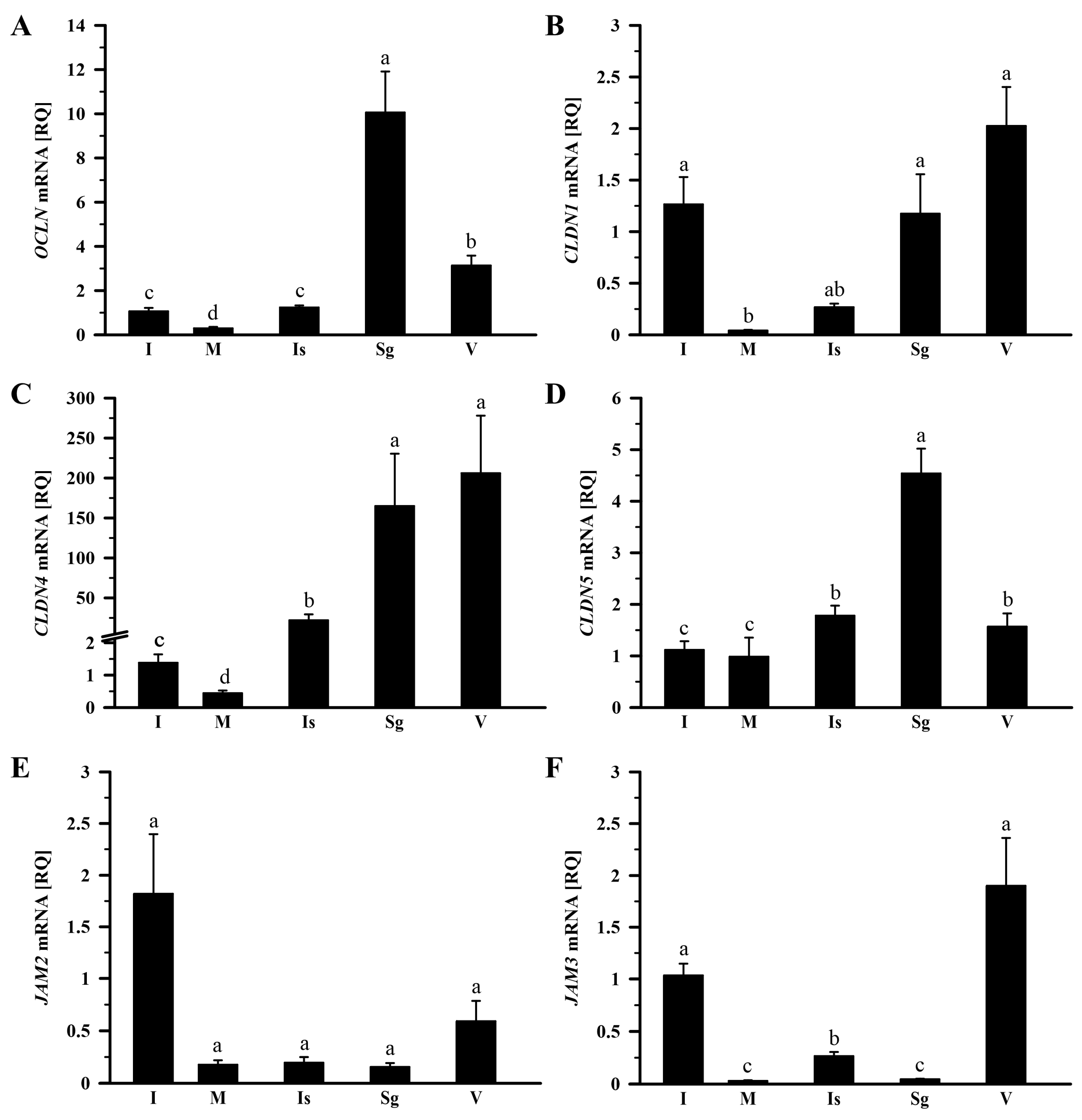
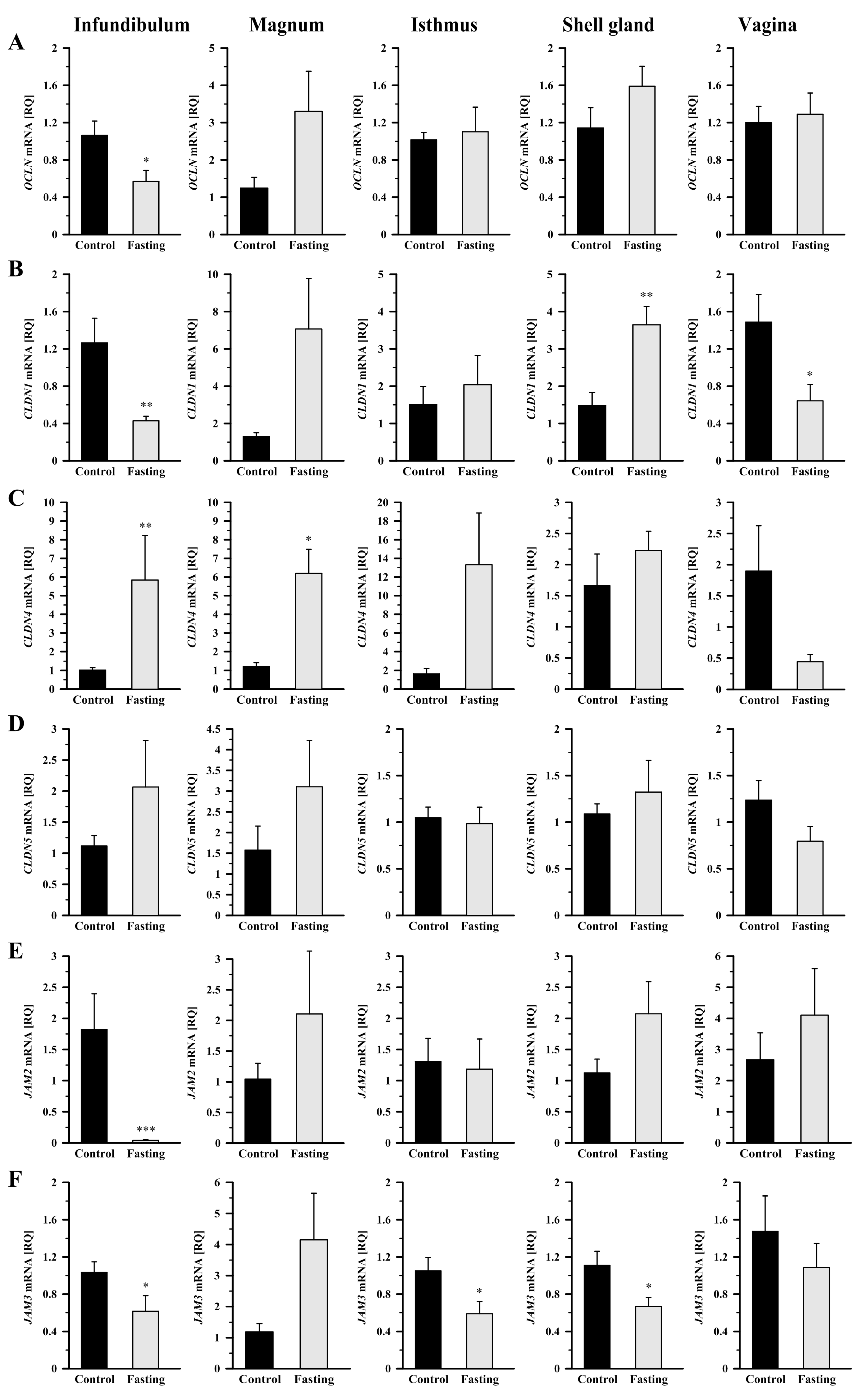

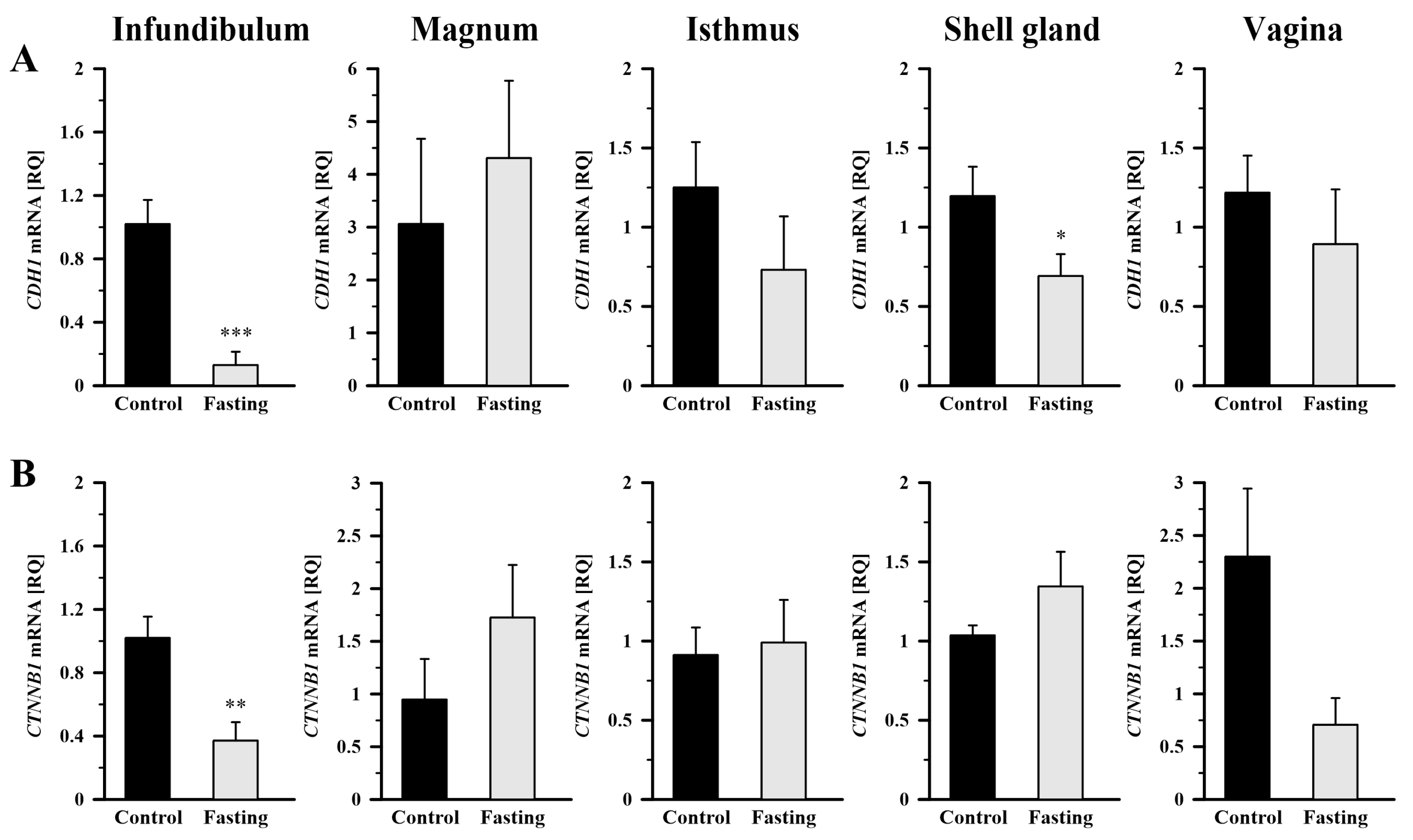

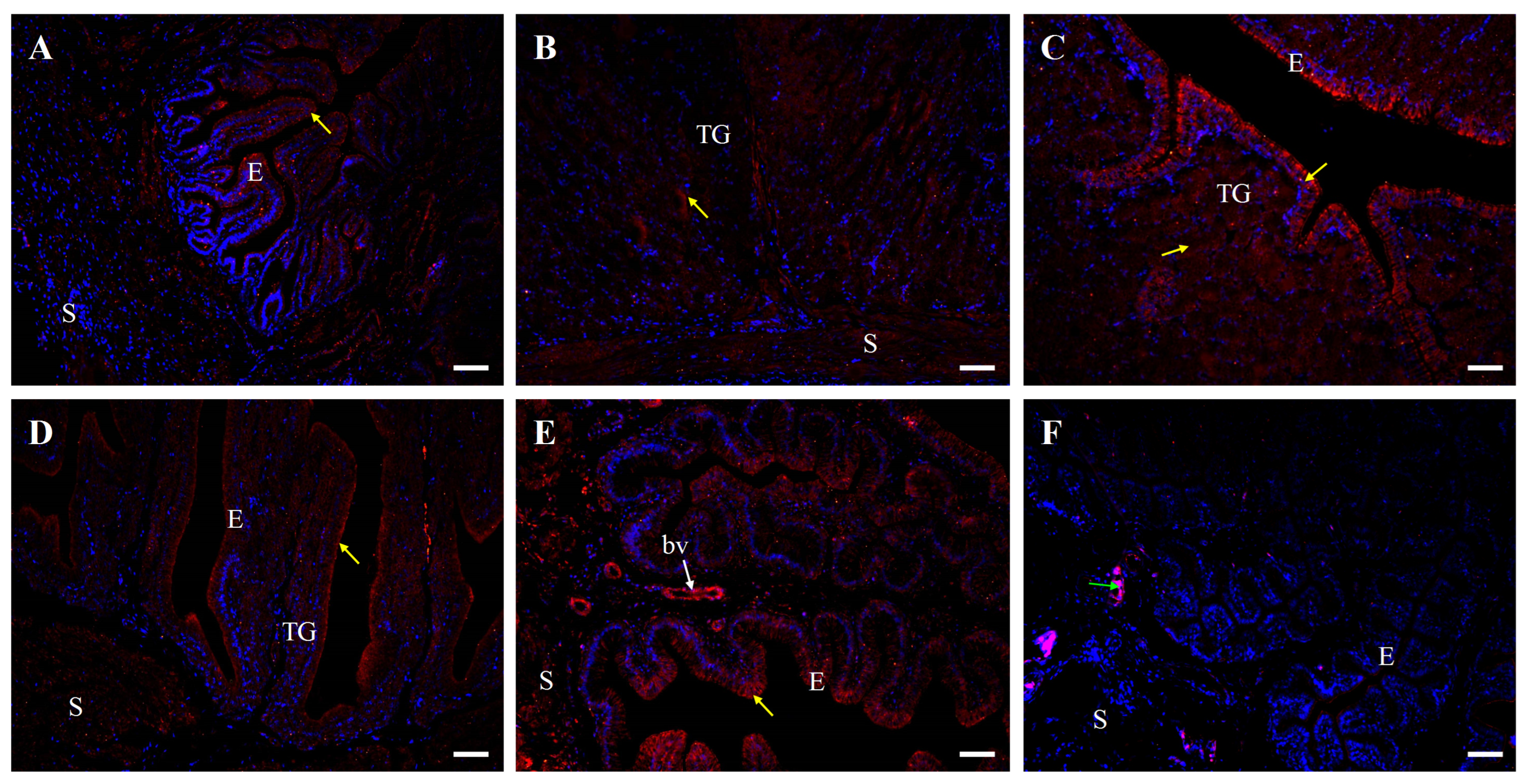
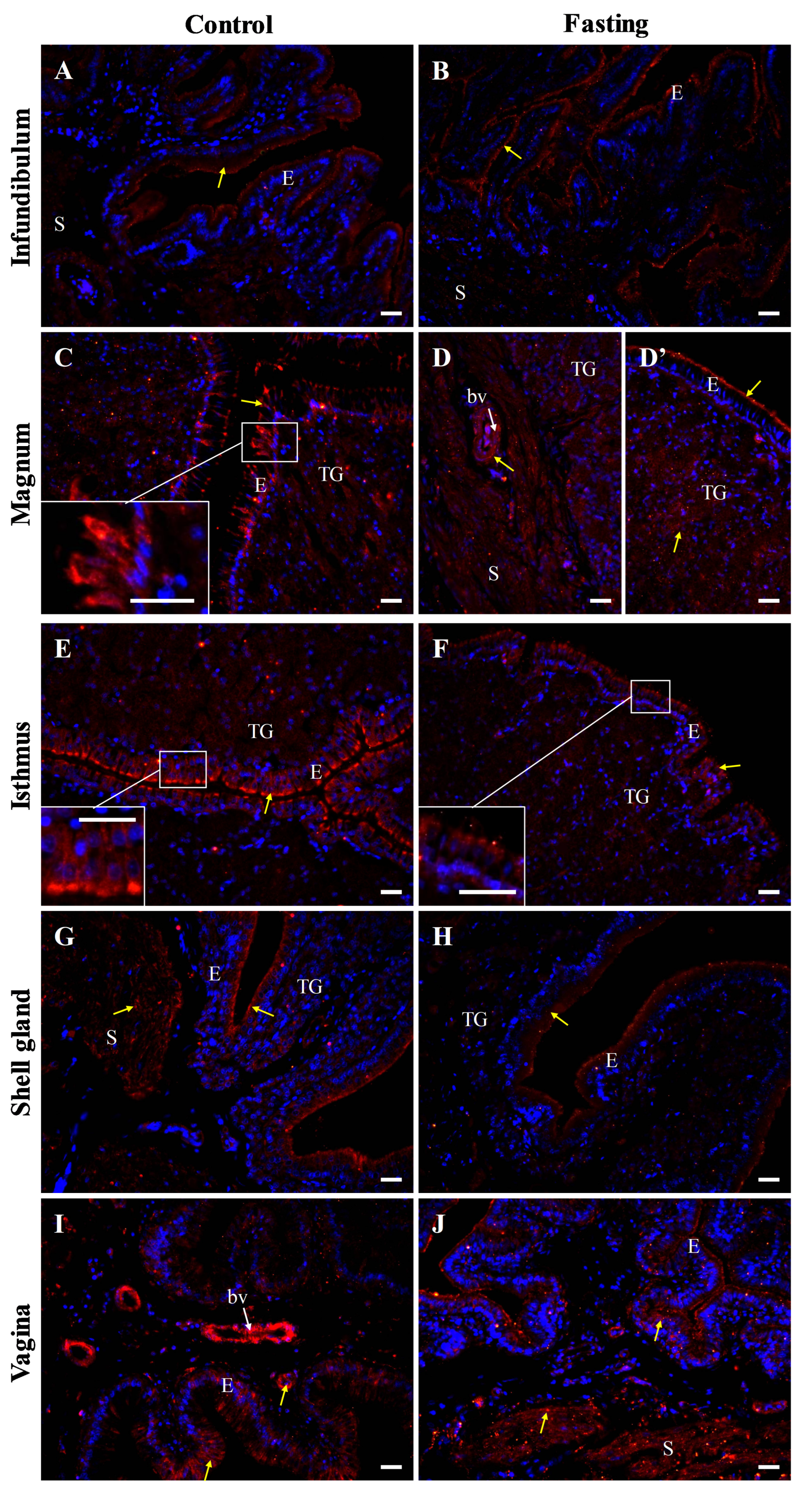
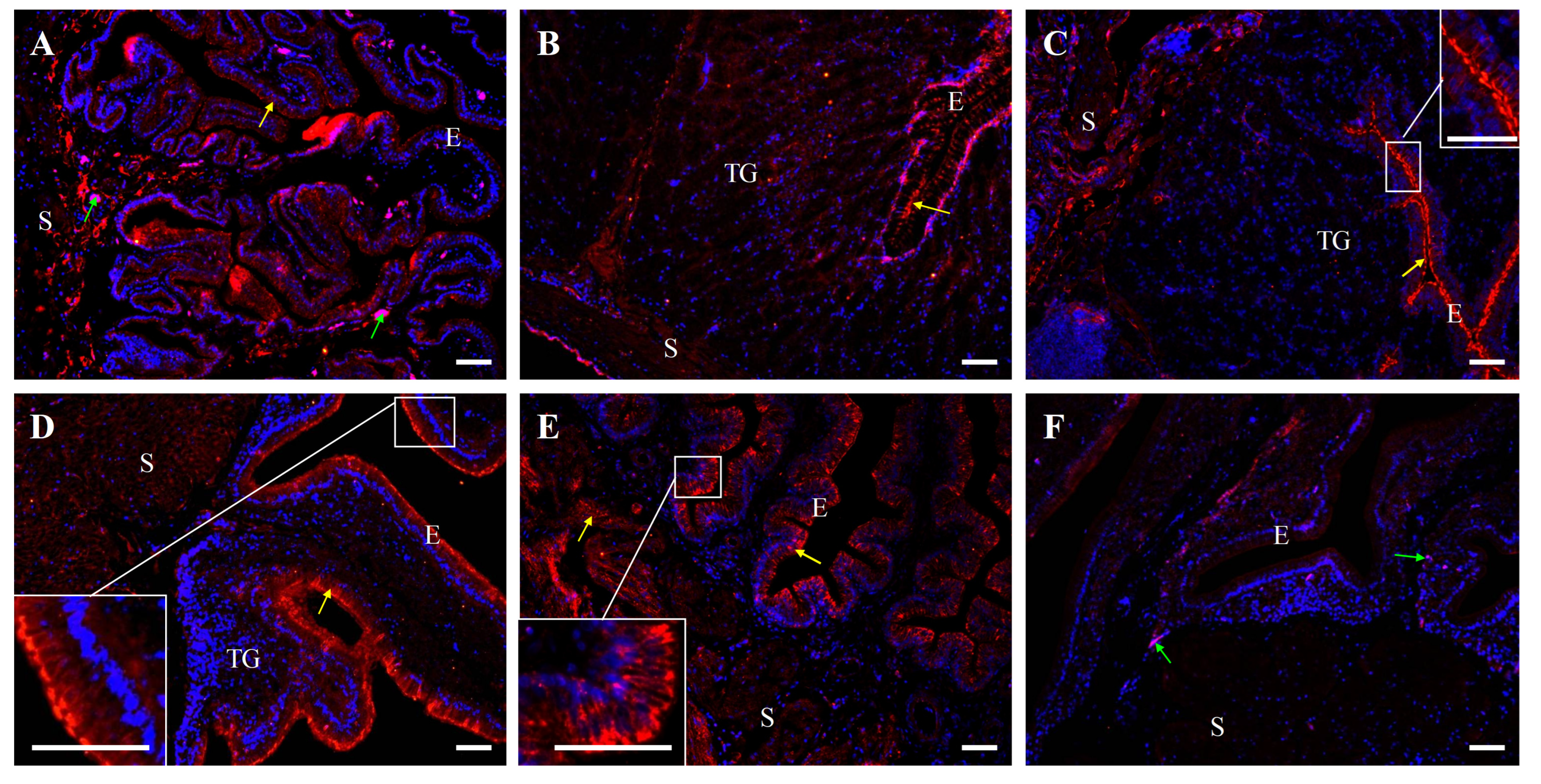
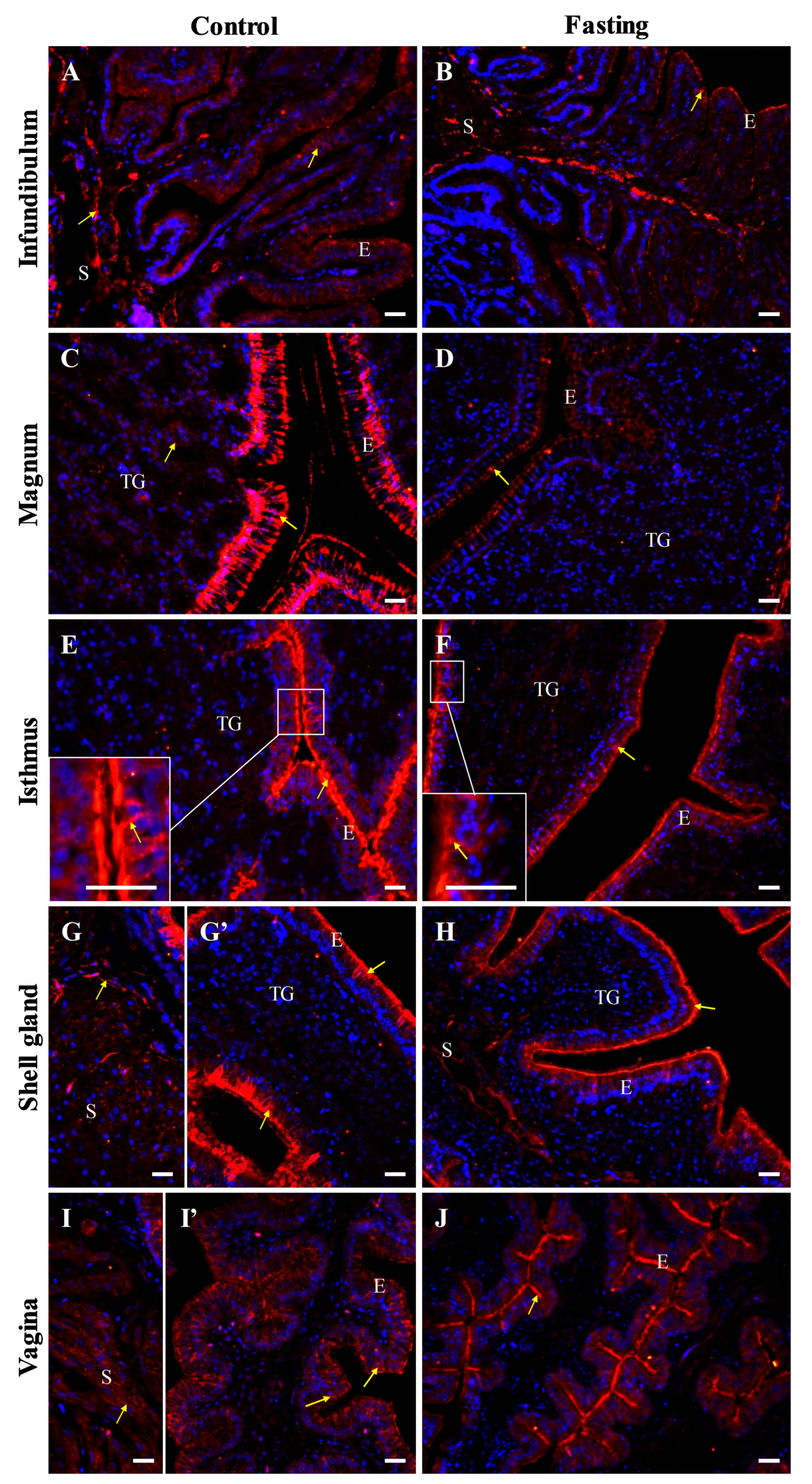

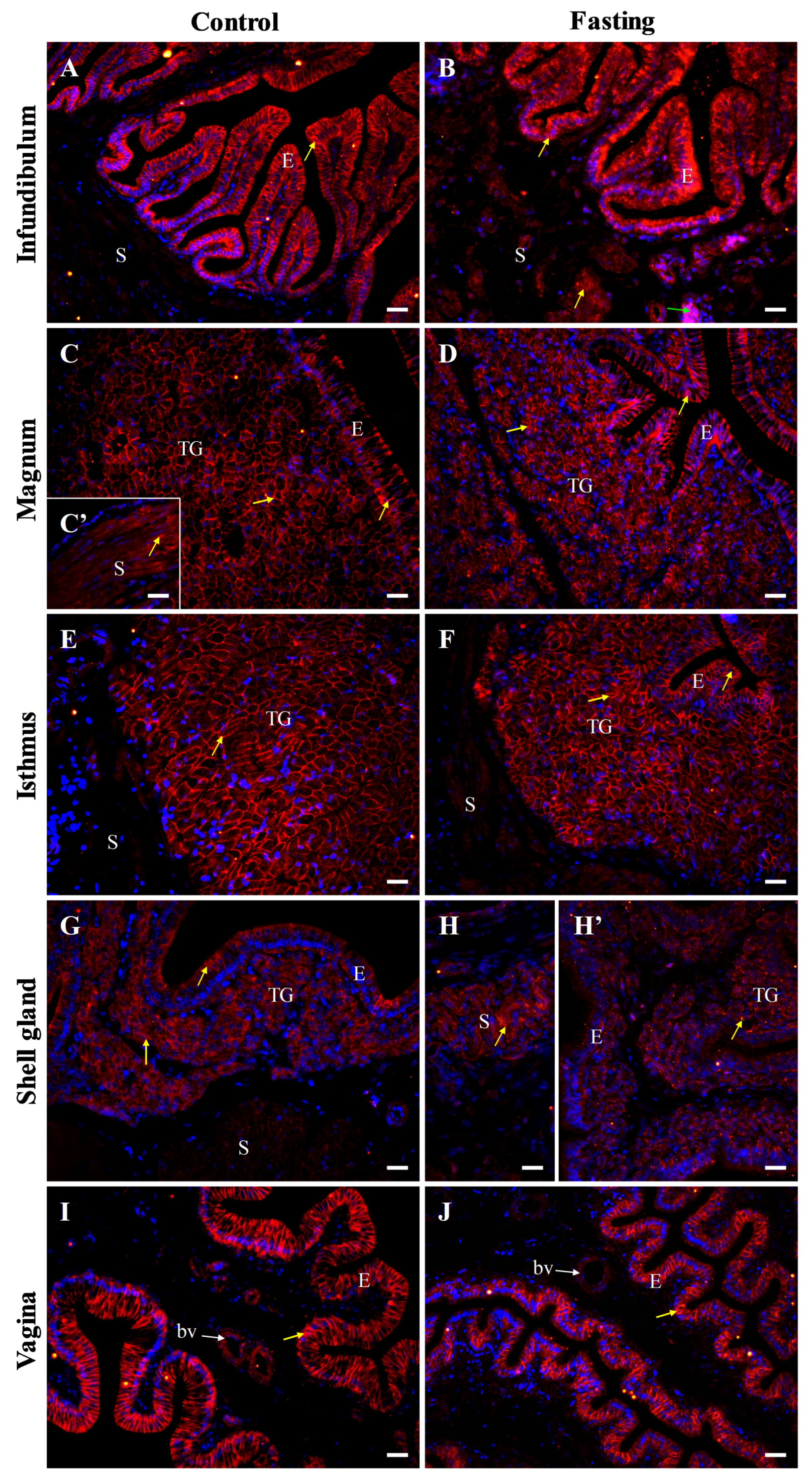
| Gene | GenBank Accession No. | Primers | Amplicon Size (bp) | References |
|---|---|---|---|---|
| CDH1 | NM_001039258 | F: 5′-TGGAGCCGGGCGAGTACAATATCTT-3′ R: 5′-TAGTCGAACACCAGCAGCGAGTCGTA-3′ | 532 | [58] |
| CLDN1 | AY750897 | F: 5′-GACTCGCTGCTTAAGCTGGA-3′ R: 5′-AAATCTGGTGTTAACGGGTG-3′ | 276 | [25] |
| CLDN4 | AY435420 | F: 5′-ATCGCCCTGTCCGTCATC-3′ R: 5′-ACCACGCAGTTCATCCACAG-3′ | 137 | [55] |
| CLDN5 | NM_204201 | F: 5′-AGGTGTCAGCCTTCATCGAC-3′ R: 5′-CCAGGATGGAATCGTACACC-3′ | 123 | [55] |
| CTNNB1 | NM_205081.3 | F: 5′-TATCCCACGGCTAGTTCAGC-3′ R: 5′-TACAGCCCTCAACGATTTCC-3′ | 125 | [27] |
| JAM2 | XM_015299112 | F: 5′-CTGCTCCTCGGGTACTTGG-3′ R: 5′-CCCTTTTGAAAATTTGTGCTTGC-3′ | 135 | [55] |
| JAM3 | XM_417876 | F: 5′-CCAGAGTGTTGAGCTGTCCT-3′ R: 5′-AGAATTTCTGCCCGAGTTGC-3′ | 147 | [55] |
| OCLN | NM_205128 | F: 5′-GATGGACAGCATCAACGACC-3′ R: 5′-CTTGCTTTGGTAGTCTGGGC-3′ | 142 | [55] |
| 18S rRNA | L21170.1 | F: 5′-GAGCTCTTTCTCGATTCCGTGGG-3′ R: 5′-GCCAGAGTCTCGTTCGTTATCGG-3′ | 96 | [59] |
| Antibody | Serum | Host Species | Vendor | Cat. no | WB Dilution | IF Dilution |
|---|---|---|---|---|---|---|
| Beta-catenin | NGS | Rabbit | Invitrogen, Carsband, CA, USA | 71-2700 | 1:1000 | 1:75 |
| E-cadherin | NGS | Rabbit | Invitrogen, Carsband, CA, USA | PA5-19479 | 1:1000 | 1:100 |
| Occludin | NGS | Rabbit | Invitrogen, Carsband, CA, USA | 71-1500 | 1:250 | 1:75 |
| Goat anti-rabbit HRP | - | Goat | Advansta Inc., San Jose, CA, USA | R-05072-500 | 1:5000 | - |
| Anti-beta-actin HRP | - | Mouse | Sigma-Aldrich, St. Louis, MO, USA | A2228 | 1:500 | - |
| DyLight 594-anti rabbit | - | Goat | Vector Laboratories, Burlingame, CA, USA | DI-1594-1.5 | - | 1:150 |
Disclaimer/Publisher’s Note: The statements, opinions and data contained in all publications are solely those of the individual author(s) and contributor(s) and not of MDPI and/or the editor(s). MDPI and/or the editor(s) disclaim responsibility for any injury to people or property resulting from any ideas, methods, instructions or products referred to in the content. |
© 2025 by the authors. Licensee MDPI, Basel, Switzerland. This article is an open access article distributed under the terms and conditions of the Creative Commons Attribution (CC BY) license (https://creativecommons.org/licenses/by/4.0/).
Share and Cite
Frydrych, K.; Hrabia, A. Tissue Regression-Related Alterations in the Expression of Adherens and Tight Junction Proteins in the Hen Oviduct. Int. J. Mol. Sci. 2025, 26, 9451. https://doi.org/10.3390/ijms26199451
Frydrych K, Hrabia A. Tissue Regression-Related Alterations in the Expression of Adherens and Tight Junction Proteins in the Hen Oviduct. International Journal of Molecular Sciences. 2025; 26(19):9451. https://doi.org/10.3390/ijms26199451
Chicago/Turabian StyleFrydrych, Karolina, and Anna Hrabia. 2025. "Tissue Regression-Related Alterations in the Expression of Adherens and Tight Junction Proteins in the Hen Oviduct" International Journal of Molecular Sciences 26, no. 19: 9451. https://doi.org/10.3390/ijms26199451
APA StyleFrydrych, K., & Hrabia, A. (2025). Tissue Regression-Related Alterations in the Expression of Adherens and Tight Junction Proteins in the Hen Oviduct. International Journal of Molecular Sciences, 26(19), 9451. https://doi.org/10.3390/ijms26199451





